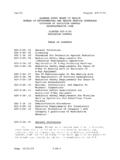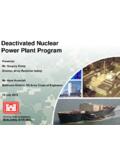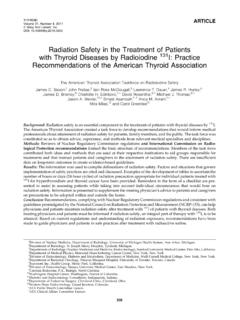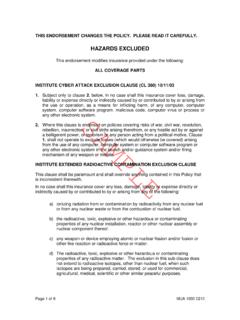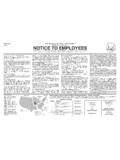Transcription of Australian Radioactive Waste Management Framework
1 Department of Industry, Innovation and ScienceApril 2018 Australian Radioactive Waste Management Framework Commonwealth of Australia 2018 ISBN 978-1-925050-04-2 (print) 978-1-922125-51-4 (online)CitationAustralian Radioactive Waste Management Framework April 2018, Australian Government Department of Industry, Innovation and Science, the exception of the Commonwealth Coat of Arms, this work is licensed under a Creative Commons Attribution International licence (CC BY ) a third party holds copyright in this material, the copyright remains with that party. Their permission may be required to use the material. Please contact them Radioactive Waste Management FrameworkiiiContentsDefinitions iv1 Summary 12 Introduction 23 Background Categories of Waste Volumes and storage of Waste National Radioactive Waste Management facilities 44 Radioactive Waste Management policy 55 Roles and responsibilities for Radioactive Waste Management International agreements and Commonwealth legislation Commonwealth policy and regulatory bodies State and territory governments Radioactive Waste producers and managers Radioactive Waste Management coordination function National Radioactive Waste Management Facility 86 Core elements of Radioactive Waste Management National inventory and classification system Australia s Radioactive Waste types Exempt
2 Waste Low Level Waste (LLW) Intermediate Level Waste (ILW) Spent nuclear fuel reprocessing Material subject to Safeguards Act Disused sealed Radioactive sources Naturally Occurring Radioactive Material Waste Acceptance Criteria Research and development (R&D) requirements Radioactive Waste Management obligations and liability prior to acceptance Transportation of Radioactive Waste material Financial arrangements for Radioactive Waste Management International engagement and reporting on Radioactive Waste 14 Attachment 1. Key international treaties and Commonwealth legislation relevant to Radioactive Waste Management 15 Attachment 2. Australia s current institutional arrangements for managing Radioactive Waste 17 Australian Radioactive Waste Management FrameworkivDefinitionsARPANSAA ustralian radiation protection and Nuclear Safety AgencyARPANS ActAustralian radiation protection and Nuclear Safety Act 1998 (Cth)ANSTOA ustralian Nuclear Science and Technology OrganisationASNOA ustralian Safeguards and Non-proliferation OfficeCSIROC ommonwealth Scientific and Industrial Research OrganisationCPPNMC onvention on the Physical protection of Nuclear MaterialEPBC ActEnvironment protection and Biodiversity Conservation Act 1999 (Cth)IAEAI nternational Atomic Energy AgencyI LWIntermediate Level WasteILWDFI ntermediate Level Waste Disposal FacilityL LWLow Level WasteNDRPN ational Directory for radiation ProtectionNORMN aturally Occurring Radioactive MaterialNPTT reaty on the Non-Proliferation of Nuclear Weapons (Non-Proliferation Treaty)
3 NRWM ActNational Radioactive Waste Management Act 2012 (Cth)NRWMFN ational Radioactive Waste Management FacilityRWMOR adioactive Waste Management OrganisationSafeguards ActNuclear Non-Proliferation (Safeguards) Act 1987 (Cth)The departmentDepartment of Industry, Innovation and ScienceThe Joint ConventionThe Joint Convention on the Safety of Spent Fuel Management and on the Safety of Radioactive Waste ManagementWACW aste Acceptance CriteriaAustralian Radioactive Waste Management Framework11 SummaryPurpose This Framework sets out principles and long term goals for Radioactive Waste Management in AustraliaThe need for a Framework nEstablishing appropriate institutional arrangements and setting out clear practices and policies on coordinating and managing Radioactive Waste Management between jurisdictions will help to meet policy objectives. nArticulating the Framework is essential preparatory work ahead of siting a National Radioactive Waste Management Facility, and developing a separate disposal option for intermediate level Waste .
4 NWhile Commonwealth agencies hold the majority of legacy and future Waste , this Framework seeks holistic engagement and input at all tiers of government, including policy objectivesSafety, security, safeguards-compliance and minimisation of Waste and appropriate safe disposal of Radioactive Waste that cannot be managed by other means. The right legislative and regulatory settings are in certainty for Waste Management licensing processes. Open and transparent Waste Management practices in line with Commonwealth and responsibilitiesConfirm roles and clarify responsibilities of the Commonwealth Government, states and territories, Waste producers / holders, regulators and policy define Waste liability arrangements both before and after acceptance of Waste at the arrangementsEstablish overarching oversight of the full life cycle Management of Australia s Radioactive Waste from production to oversight of planned activities for the complete Management of Australia s legacy.
5 Current and future an engagement plan with current long-term funding arrangementsEstablish cost structures for Waste Management activities and resources required to ensure sustainable governance clearly articulate arrangements and responsibilities for managing Australia s Radioactive Radioactive Waste Management Framework22 IntroductionAustralia is committed to providing for the safety and sustainability of Radioactive Waste Management over generations, and for the adequate allocation of financial and human resources to achieve this over time. The objective is to maintain intergenerational equity, so that the benefits received by one generation do not create obligations and unfair burdens on succeeding Australian Radioactive Waste Management Framework (the Framework ) describes the institutional arrangements for the full life cycle Management of Australia s Radioactive Waste . Full life cycle Management includes identification and monitoring of key Waste streams, Waste reduction and conditioning, requirements and methods of national Waste Management including inventory keeping and international reporting, and transportation and acceptance of Waste for long-term storage and clearly setting out the various elements of Australia s arrangements for the Management of Radioactive Waste , the Framework .
6 Nensures consistency in how Waste is managed across Australian Government agencies (as the largest Waste holders and generators) nidentifies appropriate accountability for Australia s Radioactive Waste Management practices nprovides explicit and mutually agreed principles and long-term goals to form the basis of Australia s national approach to Radioactive Waste policy making nprovides greater certainty to Commonwealth, state and territory regulators in facility licensing decisions nensures that Australia s domestic arrangements align with its international Framework will be implemented through the various strategies and operational plans of the organisations responsible for all phases of the Waste life cycle, and for regulation of these Framework draws on Radioactive Waste Management policies from leading nuclear countries with established regulatory frameworks, tailored to meet the Australian Radioactive Waste Management context.
7 By international standards, Australia has only a relatively small amount of Radioactive Waste to manage. Australia s Waste arises from important uses of nuclear research and development facilities, including a research reactor, and from the use of radioisotopes in medicine and industry. Australia has no nuclear power Framework has five main elements: nOverarching policy objectives such as safety, security, safeguards compliance and Waste minimisation nRoles and responsibilities including the responsibilities of Waste producers/holders, regulators and policy makers nInstitutional arrangements underpinning the full life cycle Management of Radioactive Waste in Australia from planning new Waste producing activities to implementing, decommissioning and Waste disposal activities nStrategic planning of Radioactive Waste Management , which identifies the main sources of Radioactive Waste in Australia, including the decommissioning of facilities, and assists in the establishment of a common national inventory for Radioactive Waste nSustainable long-term funding arrangements.
8 Including full life cycle Waste Management costs being factored into consideration of new Waste producing Radioactive Waste Management Framework33 Background1 Based on Australian radiation protection and Nuclear Safety Agency (ARPANSA) Waste classification at Categories of WasteRadioactive Waste is material that no longer has any foreseeable use and contains Radioactive materials with activities or activity concentrations at levels that require ongoing Management to ensure its safety. The Australian classification scheme for disposal of Radioactive Waste is based on the international scheme issued by the International Atomic Energy Agency (IAEA). This considers the safety of disposal pathways, taking into account the radioactivity level of the Waste and the time it will take for the radioactivity to decay (half-life). Australia s Radioactive Waste classification system and the intended pathway for storage and disposal of Commonwealth government Waste is consistent with international best practice and is outlined in Table 1.
9 Further details of these Waste types are discussed in Section addition to the safety requirements identified in the IAEA s classification guide, some material will be subject to additional regulatory requirements. For example, nuclear material (uranium, thorium and plutonium) is subject to safeguards and nuclear security regulation, irrespective of its radiological classification. There are different criteria for exemption from regulatory control for radiation safety purposes and for nuclear safeguard purposes. There are circumstances where nuclear material may be exempt from regulatory control for safety purposes because the level of radioactivity is low, but not exempt for safeguard purposes because it is still nuclear 1. Classification and disposal of Radioactive waste1 ClassificationDescriptionDisposal methodStorage facilityDisposal facilityExempt Waste (EW)Contains very low levels of radioactivity where safety measures are not be safely disposed of in the same way as non- Radioactive Waste disposal methods ( landfill)Very Short Lived Waste (VSLW)Contains very short lived be safely stored for short time periods and then disposed of the same way as non- Radioactive term storage until decayed sufficient for ordinary Waste decay, ordinary Waste disposal Low Level Waste (VLLW)Contains low levels of short lived be safely disposed of in existing industrial or commercial landfill-type facilities with limited regulatory required can go straight to require an appropriate disposal facility ( appropriately licensed landfill-type facility).
10 Low Level Waste (LLW)Contains higher levels of short lived radioactivity and low levels of long lived be safely disposed of in an engineered above-surface or near-surface (3-30 metres) at producer until transported to National Radioactive Waste Management Facility (NRWMF).NRWMFI ntermediate Level Waste (ILW)Contains higher levels of long lived be safely disposed of at greater depths (up to a few hundred metres).Onsite at producer until transported to Level Waste Disposal Level Waste (HLW)Contains levels of radioactivity high enough to generate significant amounts of heat during the Radioactive decay in deep, stable geological formations (several hundred metres below the surface) is recognised as the safe disposal does not have Radioactive Waste Management Framework4 Volumes and storage of wasteThe main holders and producers of Radioactive Waste in Australia are Commonwealth agencies, accounting for about 96 per cent of estimated ILW legacy inventories and nearly all legacy LLW as at 10 January 2018 (Table 2).
